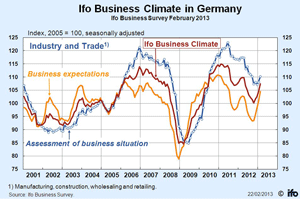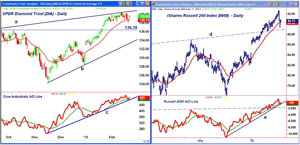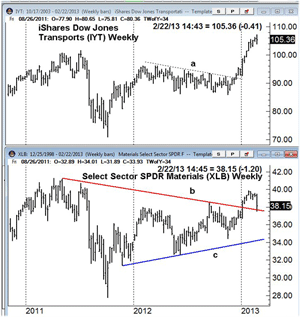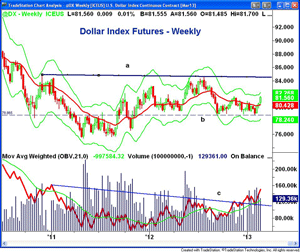Most investors were expecting a correction after the enormous surge in 2013, but evidence from Europe indicates that the downturn could be short and may have already happened with this week's blip. Still, as MoneyShow's Tom Aspray writes, this is not the time for aggressive buying, although several stocks he recommends below have fallen to acceptable buy levels.
The US stock market had a sharp two-day slide last week, and most of the major averages made their lows Thursday afternoon before turning higher into the close.
The impressive rally on Friday pushed the Dow Industrials into positive territory for the week, while the other averages finished a bit lower. Friday's close may indicate that the correction is already over.
A correction has been expected for several weeks, as up through February 15, the S&P 500 had closed higher for seven consecutive weeks. While US analysts were fixated on whether the US market would correct or not, European markets were already correcting.
The German Dax Index has been leading the S&P 500 since the June 2012 lows, up 27.8% since then against a 17.2% gain in the S&P 500. Its better relative strength was evident last November, as I discussed in Should You Invest Overseas?
The correction in the Dax from the September highs was much less severe, as it held above the 38.2% Fibonacci retracement support from the June lows. The chart of the Spyder Trust (SPY) shows that it was much weaker, briefly violating the 61.8% support from June's lows.
The Dax index topped on January 25 at 7,865, and at Thursday's low of 7,561 was down 3.8% from its highs. The daily chart also shows a fairly normal corrective pattern that has already taken the Index close to support from the September highs at 7,488. A close in the Dax above last week's high of 7,784 should signal that the correction is over.
SPY has corresponding support now at $148.44, which is about 1% below Thursday's low. Given that the Dax topped out 12 days ahead of SPY, we may see more choppy-to-downward action before its correction is over. This would be more like the first scenario I outlined last Thursday in 2 Scenarios for Market's Correction.
The focus will be on the Eurozone this week, with the Italian election this weekend. Things are so bad that a comic could come in third, as he has struck a chord with the Italian public's disillusion with politicians.
The report from the ECB that Italian bonds make up over half of its holdings from the bond-buying program is also a concern. Overall, the outlook for the Eurozone economies is negative: EU economists are forecasting a 0.3% contraction in its economy, which means a reduction in business and consumer spending and even higher unemployment.
The outlook for Germany is much more positive. The report on the Ifo business-climate index, which showed a climb to 107.4 this month from 104.3 in January, helped boost US stocks early Friday. This index is based on a survey of 7,000 executives, and they are much more positive on the economy than most experts expected. Positive growth is expected in Germany for 2013, with 2% growth in 2014.
The chart shows that this survey, along with two other measures of their economy, turned up sharply in late 2012. All are looking quite positive.
NEXT: What to Watch
|pagebreak|In the US, it was a generally disappointing week for economic news, as the Housing Market Index was weaker than expected and housing starts declined.
Also, the FOMC minutes revealed that in the January policy meeting, officials had mixed opinions on how long the easy-money policies should continue. This, of course, hit stocks rather hard last Wednesday afternoon.
Part of their concern is tied to the explosion in the high-risk or junk bond market. Companies issued $274 billion in junk debt last year, an increase of 55% over the prior year.
The chart shows that since December 2008, these bonds are up close to 150%, and yields have fallen to under 6%, as I noted last month. The Fed is also concerned with other high-yielding debt, like mortgage backed REITs, as they fear individual and institutional investors will take on too many high-risk assets.
This week, we will get a full slate of new data on the economy, starting with the Dallas Fed Manufacturing Survey on Monday. This is followed on Tuesday by the S&P Case-Shiller Housing Price Index, new home sales, and consumer confidence. On Wednesday comes the latest reading on durable goods and pending home sales.
The preliminary reading on fourth-quarter GDP comes out Thursday, along with jobless claims and the Chicago Purchasing Managers Index. The week ends with Personal Income and Outlays, the PMI Manufacturing Index, consumer sentiment, and the ISM Manufacturing Index on Friday.
What to Watch
The rebound Friday was pretty impressive, and suggests that maybe my second scenario from last week is the correct one.
Several prominent analysts came out with very negative comments last Thursday, and it is likely quite a few new short positions were established. If stocks can continue higher Monday on positive market internals, we could see quite a squeeze. If the major averages do make new highs, it will be important to watch the technical indicators to see if any divergences are formed.
Sentiment improved a bit last week, as financial newsletter writers became a bit less bullish, dropping from 52.6% to 48.4%. Only 41.8% of individual investors are now bullish, down from 52.3% on January 24.
Using Wednesday's high and Thursday's low, the S&P futures were down 2.3%, which was very similar to the 2% drop in 2012 that I discussed last week. In 2012, the correction was followed by another month on the upside, as SPY rallied from a low of $134.36 to a high of $142.21.
NEXT: Stocks and Tom's Outlook
|pagebreak|The daily chart of the NYSE Advance/Decline line shows that it dropped below its WMA on Thursday, but was back above it with Friday's close. The A/D line did make new rally highs last week, and has long-term support at line c.
The NYSE Composite did test its daily Starc- band Thursday (see arrow) and closed the week right on the flat 20-day EMA. There is next resistance at 8,900 and then in the 9,000 area. The daily uptrend (line b) was broken Thursday, but prices regained it on Friday.
S&P 500
The Spyder Trust (SPY) dropped just barely below the $150 level Thursday before closing Friday back above Thursday's high. Those who stayed short over the weekend are likely a bit nervous.
The decline held above the more widely watched support at $149.50. Additional support waits at 148.15 (line d), which was the September high.
The S&P 500 A/D line did make new highs last week before dropping below its WMA. With Friday's close, the A/D line is back above its flattening WMA.
SPY closed above the 20-day EMA at $150.80, with next resistance at $152. A daily close above last week's high of $153.28 should be enough to reverse the short-term negative sentiment.
Dow Industrials
The drop in the SPDR Diamond Trust (DIA) last Thursday held just above the $138 level, and DIA did close the week higher. There is more important support from last fall at $136.39.
The Dow Industrials A/D line tested its uptrend (line c) and broke its WMA before turning higher. A close above last week's high at $140.28 is likely to be confirmed by the A/D line. There is next major resistance from 2007 at $141.95, with the weekly Starc+ band at $144.54.
The weekly relative performance (not shown) has improved and may be bottoming; a higher close this week could confirm it. This may be signaling that the blue chips are going to start leading the market.
Russell 2000
The iShares Russell 2000 Index (IWM) was hit hard last Wednesday and Thursday, as IWM hit a low of $89.37 before it stabilized. The decline held above the chart support (line d) at $88.90, with the monthly pivot support at $87.
The Russell 2000 A/D line also dropped down to test its uptrend (line e) last week, but closed back above its WMA. If IWM makes a new high in the next few days, it could form a negative divergence.
There is resistance now at $91.67 to $92.68, with the weekly Starc+ band at $95.36.
Nasdaq-100
The PowerShares QQQ Trust (QQQ) dropped briefly below the stronger support at $66.46, but held above the monthly pivot support at $66.10.
The Nasdaq-100 A/D line (not shown) dropped below its WMA on Wednesday, and while it did turn up on Friday, it is still below its WMA. QQQ has first resistance at $67.57, followed by $68.25 to $68.56.
NEXT: Sector Focus, Commodities, and Tom's Outlook
|pagebreak|Sector Focus
The iShares Dow Jones Transportation (IYT) made another new high last week, but closed the week a bit lower. The range for the week was quite wide, with support now at $104 and resistance at $107.26.
The move through the resistance (line a) in mid-December was a strong sign that this previously lagging sector was going to catch up. It is now a market leader.
The ranges in the sector ETFs were much wider last week, and there were some sectors that showed nice gains while others were hit fairly hard. The weakest was the Select Sector SPDR Materials (XLB), down 3%.
The weekly chart shows that the breakout level (line b) from the 2011 highs has been tested. It will be important that XLB is able to turn higher in the next few weeks.
Also on the downside was the Select Sector SPDR Consumer Discretionary (XLY), which lost about 1.6%. The Select Sector SPDR Energy (XLE) closed down 1%.
Defensive sectors did the best, as the Select Sector SPDR Consumer Staples (XLP) was up 1.5% and the Select Sector SPDR Utilities (XLU) gained 1.2%.
Crude Oil
The drop in crude oil below support at $95.53 early Wednesday preceded the sharp drop in the stock market. There were warnings from the crude oil market the previous week, and stock traders should always keep an eye on crude oil because it often leads stocks.
The April contract is not far above the support in the $92 area, and it looks as though the worst of the selling may be over.
.Interest Rates
The yield on the ten-year T-Note was down a bit last week, but is still in a clear uptrend. Its still-rising 20-day EMA stands at 1.833%.
Precious Metals
The SPDR Gold Trust (GLD) had another rough week, as it tried to stabilize last Tuesday before again gapping to the downside. The three gaps make it overdue for a bounce, and clearly the sentiment for gold is quite negative.
Currencies
The dollar was quite strong last week, and the weekly chart of the dollar index futures suggests that an important low may now be in place. The dollar has rallied sharply from the support at 78.86 (line b).
The dollar index closed just below the resistance at 81.66, with more important resistance now at 84.66 (line a). The weekly OBV looks very strong, as it broke its downtrend last December and then retested its rising WMA four weeks ago. This was the type of bullish setup I discussed in my recent article on the OBV.
The Week Ahead
Last week's trading showed an increase in volatility, and this is likely to continue this week. Over the past few weeks, I have been taking profits on some of the stocks that have done quite well since the end of last year, as well as raising some stops.
The cash in the Charts in Play portfolio has risen to 64%, but some new buying has been done. A number of stocks have reached my buying levels, like the Next Boom stocks I originally covered at the end of January.
Clearly, this is still not the time to be an aggressive buyer, and new buying is best suited for those who have been participating in the recent rally. A drop below last week's lows in leading market-tracking ETFs will signal that the correction is not over.
As always, it is important to have your stops and a clear plan in place for your current holdings. I continue to feel a focus on your entry level and risk will be important this year.
- Don't forget to read Tom's latest Trading Lesson, 5 Rules for Success in 2013.

















